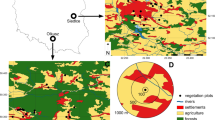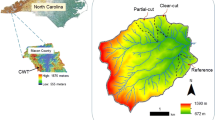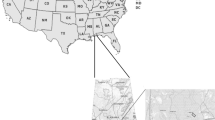Abstract
This study established for the first time the impact of harvesting on post-harvest papyrus (Cyperus papyrus L.) biomass regeneration potential, with two harvesting regimes compared. Above-ground papyrus biomass was determined. Biomass varied with site. Site had no effect on regeneration potential, but monthly harvesting reduced papyrus biomass regeneration potential among sites. However, seasonal (6-monthly) harvesting did not appear to affect papyrus biomass regeneration potential. Exponential and polynomial trend analyses revealed a consistent downward trend for monthly harvest biomass, and the polynomial trend was more linear (F = 97.913; P < 0.001) than periodic (F = 9.617; P < 0.05). The polynomial trend scenario indicated how papyrus biological dynamics are likely to behave as monthly harvests are repeated. This suggests that regeneration potential is significantly reduced with successive monthly harvest, leading to weak spatial connectivity, papyrus stand fragmentation, and increased landscape patchiness. A 6-month harvest regime can be established to regenerate more biomass between harvests than is currently the case, with positive implications for wetland conservation and carbon sequestration. Papyrus harvesters can be kept off the swamps by establishing a riparian buffer zone of agro forestry trees and shrubs which can substitute for the papyrus as it is left to mature. However, while the information presented is useful for papyrus wetland management strategies, it is recognized that the study period was too short to permit a generalized recommendation.





Similar content being viewed by others
References
Abebe Y D (2003) Wetlands of Ethiopia: an introduction. In: Abebe YD, Geheb K (eds) Wetlands of Ethiopia. Proceedings of a seminar on the resources and status of in Ethiopia’s wetlands, IUCN Eastern Africa Regional Office, Nairobi, Kenya, IUCN—The World Conservation Union CH-1196 Gland, Switzerland www.iucn.org/themes/wetlands
Archer C (2004) Cyperus papyrus L. National Herbarium. Pretoria, May 2004. http://www.plantzafrica.com
Bacon PR (1997) Wetlands and biodiversity. In: Hails AJ (ed) Wetlands, biodiversity and the Ramsar convention: the role of the convention on wetlands in the conservation and wise use of biodiversity. Ramsar Convention Bureau, Gland, Switzerland, pp 7–21
Boar RR (2006) Responses of a fringing Cyperus papyrus L. swamp to changes in water level. Aquat Bot 84(2):85–92
Boar RR, Harper DM, Adams CS (1999) Biomass allocation in cyperus papyrus in a tropical wetland, Lake Naivasha, Kenya. Biotropica 31(3):411–421
Burnmeister M (2001) Cyperus papyrus: from the Nile to Modern Times. Ethnobotanical leaflets. Southern Illionis University Carbondale (SIUC) College of Science. http://www.siu.edu
Chale FMM (1987) Plant biomass and nutrient levels of a tropical macrophyte (Cyperus papyrus) receiving domestic wastewater. Aquatic Ecol 21(2):167–170
Chiariello NR, Money HA, Williams K (1991) Growth, carbon allocation and cost of plant tissues. In: Pearcy RW et al (eds) Plant physiological ecology: field methods and instrumentation. Chapman and Hall, London
Gaudet JJ (1977) Uptake, accumulation and loss of nutrients by papyrus in tropical swamps. Ecology 58:415–422
Hails AJ (ed) (1997) Wetlands, biodiversity and the Ramsar convention: the role of the convention on wetlands in the conservation and wise use of biodiversity. Ramsar Convention Bureau, Gland, Switzerland, 153 pp
Jones MB, Muthuri FM (1985) The canopy structure and microclimate of papyrus (Cyperus papyrus) swamps. J Ecol 73(2):481–491
Jones MB, Muthuri FM (1997) Standing biomass and carbon distribution in a papyrus (Cyperus papyrus L.) swamp on Lake Naivasha, Kenya. J Trop Ecol 13(3):347–356. http://links.jstor.org
Kansiime F, Nalubega M, van Bruggen JJ, Denny P (2003) The effect of wastewater discharge on biomass production and nutrient content of Cyperus papyrus and Miscanthidium violaceum in the Nakivubo wetland, Kampala, Uganda. Water Sci Technol 48(5):233–240
Kasoma P (2003) Lake Victoria research (VicRes) initiative. Wetland research in the Lake Victoria basin, Uganda part: analysis and synthesis report. The inter-university council of East Africa. SIDA–SAREC, May 2003. www.iucea.org
Kendall RL (1969) An ecological history of the Lake Victoria basin. Ecol Monogr 39(2):121–176
Kipkemboi J (2006) Fingerponds: seasonal integrated aquaculture in East African freshwater wetlands: exploring their potential for wise use strategies. PhD dissertation, Wageningen University, The Netherlands. www.balkema.nl, www.taylorandfrancis.co.uk, www.crcpress.com
Kotera A, Nawata E (2007) Role of plant height in the submergence tolerance of rice: a simulation analysis using an empirical model. Agric Water Manage 89(2):49–58
Květ J, Westlake DF, Dykjova D, Marshall EJP, Ondok JP (1998) Primary production in wetlands. In: Westlake DF, Kvét J, Szezepariski A (eds) The production ecology of wetlands: the BPSynthesis. Cambridge University Press, Cambridge, UK, pp 78–168
Lind EM, Visser SA (1962) A study of a swamp at the north end of Lake Victoria. J Ecol 50:599–613
LVEMP (1999) Lake Victoria and its basin: an important national asset. Lake Victoria information bulletin, Issue No 1, February 1999. A newsletter of Lake Victoria environment management programme (LVEMP), Ministry of Natural Resources, Kenya
Mallory K, Chandler M (2001) Lake Victoria: Africas inland sea. New England Aquarium, Central Whar, Boston, MA, pp 02110–03399
McClanahan TR, Young TP (eds) (1996) East African ecosystems and their conservation. Oxford University Press, New York
Mead R (1990) The design of experiments: statistical principles for practical application. Cambridge University Press, Cambridge, UK
Mnaya et al (2007) Primary production in papyrus (Cyperus papyrus L.) of Rubondo Island, Lake Victoria, Tanzania. Wetlands Ecol Manage 15(4):269–275
Omollow MO (2003) The importance of wetland plant resources and agricultural products in the Nyando river wetlands, Kenya: a comparative study of papyrus and rice. M Phil thesis, School of Environmental Studies, Moi University, Kenya
Owino AO (2005) Papyrus swamp habitat loss and degradation: impacts on endemic birds in Kenya. M Sc thesis, Percy FitzPatrick Institute of African Ornithology, University of Capetown, Rondebosch, South Africa. www.nrf.ac.za
Owino AO, Ryan PG (2007) Recent papyrus swamp habitat loss and conservation implications in western Kenya. Wetlands Ecol Manage 15(1):1–12. www.springerlink.com
Pearcy RW, Ehleringer JR, Mooney HA, Rundel PW (eds) (1991) Plant physiological ecology: field methods and instrumentation. Chapman and Hall, London, 325 pp
Roberts MJ, Long SP, Tieszen LL, Beadle CL (1993) Measurement of plant biomass and net primary production of herbaceous vegetation. In: Hall DO, Scurlock JMO, Bolhar-Nordenkampf HR, Leegood RC, Long SP (eds) Photosynthesis and production in a changing environment: a field and laboratory manual. UNEP/Chapman and Hall, London, pp 1–21
Slingsby D, Cook C (1986) Practical ecology. MacMillan Education Limited, London, p 213
Sutherland WJ (1996) Why census? In: Sutherland WJ (ed) Ecological census techniques: a handbook. Cambridge University Press, Cambridge, pp 1–10
Thenya T (2006) Analysis of macrophyte biomass productivity, utilization and its impact on various eco-types of Yala Swamp, Lake Victoria Basin, Kenya Ecology and Development Series No. 48. Editor-in-Chief: Paul LG Vlek. Editors: Manfred Denich, Christopher Martius, Charles Rodgers, Cuvillier Verlag Göttingen, 207 pp
Twong’o TK, Sikoyo GM (2004) Status of Lake Victoria ecosystems. In: Twong’o TK, Sikoyo GW, Wakhungu JW (eds) An overview of the status of shared aquatic ecosystems in East Africa: status and trends. African Centre for Technology Studies (ACTS), Nairobi, Kenya, pp 4–40. www.acts.or.ke/biodiversity
Underwood AJ (1997) Experiments in ecology: their logical design and interpretation using analysis of variance. Cambridge university press, Cambridge, UK 325 pp
van Dam AA, Dardona A, Kelderman P, Kansiime F (2007) A simulation model for nitrogen retention in a papyrus wetland near Lake Victoria, Uganda (East Africa). Wetlands Ecol Manage 15(6):469–480
Vignoli L, Carpaneto GC, Cozar A (2004) An ecological research on fish species in the papyrus stand ecotone of Lake Victoria, Uganda and Kenya. www.bio.nu.nl
Acknowledgments
The authors are grateful to the Chairman of the Department of Environmental Biology and Health and to the Dean of the School of Environmental Studies for the opportunity to undertake this study. Many thanks also to the Director General of Victoria International Institute for Research on Environment and Development (VIRED International) for accepting to attach the lead author to their Institute during fieldwork. Our families and relatives gave us the cooperation and moral support throughout the study. Professor Hans Gottgens and the editorial team of Wetlands Ecology and Management Journal enriched the outcome through their review of the manuscript. The authors feel greatly indebted to all of them.
Author information
Authors and Affiliations
Corresponding author
Rights and permissions
About this article
Cite this article
Osumba, J.J.L., Okeyo-Owuor, J.B. & Raburu, P.O. Effect of harvesting on temporal papyrus (Cyperus papyrus) biomass regeneration potential among swamps in Winam Gulf wetlands of Lake Victoria Basin, Kenya. Wetlands Ecol Manage 18, 333–341 (2010). https://doi.org/10.1007/s11273-010-9174-2
Received:
Accepted:
Published:
Issue Date:
DOI: https://doi.org/10.1007/s11273-010-9174-2




